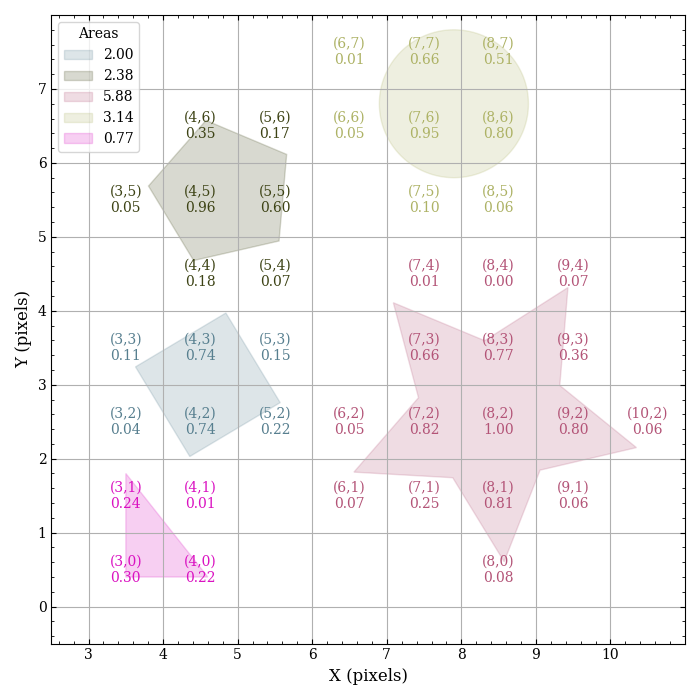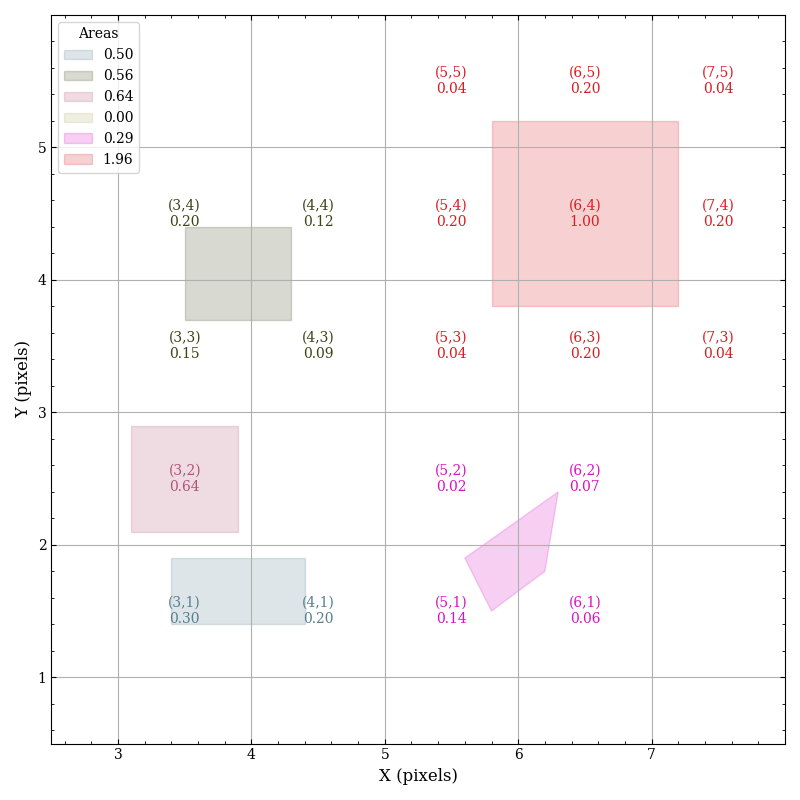pypolyclip
A Python package to clip polygons against a pixel grid.
The polyclip functions were originally developed for the CUBISM project Smith et al. 2007 (PASP 119, 1133).
Installation
The package can be installed using pip from the command line:
pip install pypolyclip
Description
The polyclip code employs the Sutherland-Hodgman algorithm to clip simple polygons against a tessellated grid of square pixels. Therefore, this differs from similar packages, which often clip between two arbitrary polygons.
The test module test_pypolyclip.py can be run to produce the following example figures:
In each figure, the Cartesian coordinates for each pixel that overlaps with a given polygon are labeled with the area of that pixel that is covered (the area of a pixel is defined as 1). Therefore, the sum of the areas of the individual pixels for each polygon should be the total area of the polygon.
Pypolyclip uses a coordinate grid where integer pixel coordinates are located at the lower-left corner of each pixel, starting from zero. To clip polygons on a coordinate grid where integer pixel coordinates are located at the center of pixels, one will need to add 0.5 pixel to both the x and y vertices of the input polygons.
The first figure shows clipping of polygons with differing numbers of vertices, which internally requires the use of "for loops". However, if the number of vertices is the same for all polygons (such as the second figure), then NumPy is used internally to improve performance by several percent.
Example usage
This first example demonstrates polygons with the same number of vertices:
import numpy as np
from pypolyclip import clip_multi
# define the size of the pixel grid
naxis = (100, 100)
# create 3 polygons to clip
# the x-vertices of the polygon
px = np.array([[3.4, 3.4, 4.4, 4.4],
[3.5, 3.5, 4.3, 4.3],
[3.1, 3.1, 3.9, 3.9]])
# the y-vertices of the polygon
py = np.array([[1.4, 1.9, 1.9, 1.4],
[3.7, 4.4, 4.4, 3.7],
[2.1, 2.9, 2.9, 2.1]])
# call the clipper
xc, yc, area, slices = clip_multi(px, py, naxis)
# xc, yc are the grid indices with overlapping pixels.
# area is the overlapping area on a given pixel.
# slices is a list of slice objects to link between the input polygons
# and the clipped pixel grid.
# the slices object can be used to get the area of each polygon
for i, s in enumerate(slices):
print(f'total area for polygon {i}={np.sum(area[s])}')
This second example demonstrates clipping polygons that have a different
number of vertices. Note that px and py are lists of lists instead
of NumPy arrays as in the first example.
import numpy as np
from pypolyclip import clip_multi
# define the size of the pixel grid
naxis = (100, 100)
# create 3 polygons to clip
# the x-vertices of the polygon
px = [[3.4, 3.4, 4.4, 4.8, 4.4],
[3.5, 3.5, 4.3, 4.3],
[3.1, 3.8, 3.1]]
# the y-vertices of the polygon
py = [[1.4, 1.9, 1.9, 1.65, 1.4],
[3.7, 4.4, 4.4, 3.7],
[2.1, 2.1, 3.4]]
# call the clipper
xc, yc, area, slices = clip_multi(px, py, naxis)
# xc, yc are the grid indices with overlapping pixels.
# area is the overlapping area on a given pixel.
# slices is a list of slice objects to link between the input polygons
# and the clipped pixel grid.
# the slices object can be used to get the area of each polygon
for i, s in enumerate(slices):
print(f'total area for polygon {i}={np.sum(area[s])}')

